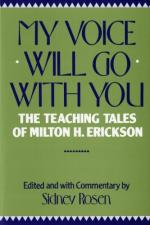
|
| Name: _________________________ | Period: ___________________ |
This test consists of 5 multiple choice questions, 5 short answer questions, and 10 short essay questions.
Multiple Choice Questions
1. People often have misconceptions and erroneous preconceived notions about which of the following?
(a) Psychiatry.
(b) Psychometry.
(c) Trance states.
(d) Energy Healing.
2. The man who was Erickson's target invited him to do what?
(a) Eat dinner.
(b) Go away.
(c) Walk the dog.
(d) Deliver a package.
3. What is the name of the person who has annotated Erickson's work?
(a) Weston.
(b) Rosen.
(c) Randall.
(d) Wilson.
4. The doctor believes people can change if only one can:
(a) Gain the patient's respect.
(b) Create a long term plan.
(c) Address one of the bigger issues.
(d) Push the right buttons.
5. Which is a form of trance?
(a) Focus.
(b) Meditation.
(c) Dance.
(d) Sleep.
Short Answer Questions
1. Another way in which a patient may be treated for a particularly difficult problem is by using the tool of:
2. The doctor was successful in helping the woman by using which technique?
3. What is one of the most common ways that a patient can block treatment?
4. Erickson's patients often think that they are:
5. The woman was told to use what kind of treatment for her problem?
Short Essay Questions
1. What was Arthur's explanation for his preparedness when it came to taking the professor's test?
2. Erickson chose to forge his own way in the practice of hypnotherapy by developing what? What were the developments designed to do?
3. What happened between Arthur and the professor? What was the conflict?
4. What is automatic writing? What is the process? How is it helpful?
5. What kind of information is given to the reader through the use of discussion regarding Erickson's techniques?
6. How did Arthur and the professor handle the situation?
7. Explain one of the doctor's main tenets of practice and the theory behind it. How does this main tenet work into the patient's overall treatment plan?
8. The author talks about rapport and relating to another person. Why should one strive to build rapport?
9. Who is Arthur? Why is Arthur's story important to the text presented by Rosen?
10. What is automatic behavior? How can it be used to help patients?
|
This section contains 750 words (approx. 3 pages at 300 words per page) |

|




